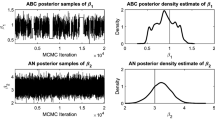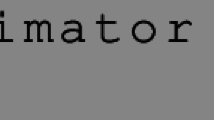Abstract
The problem of representing and analysing partial aspects of uncertainty is examined using a geometric approach. A Hilbert space of random objects is constructed, where the inner product captures aspects of beliefs about the relationship between the objects. Orthogonal direct sums of the Hilbert space are used to restrict the amount of detail that is required for the prior specification. Using minimal assumptions of temporal consistency, this geometric space is adapted to derive the stochastic relationships between the formal restricted partial belief analysis and the corresponding posterior uncertainty judgements.
To illustrate the methodology, a simple multivariate time series dynamic linear model is developed to represent the sales of leading brands of soft-drink from “cash-and-carry” depots. Restricted prior inferences are developed for the pair of variance matrices underlying this model, where uncertainty for a given depot is decomposed into aspects which may be explained with data from that depot, those which may be explained using data from related depots, and those aspects of our uncertainty for our posterior judgements which cannot be explained a priori.
Similar content being viewed by others
References
R.G. Cowell, A.P. Dawid, S.L. Lauritzen and D.J. Spiegelhalter, Probabilistic Networks and Expert Systems (Springer, Berlin, 1999).
B. de Finetti, Theory of Probability, Vol. 1 (Wiley, Chichester, 1974).
M. Goldstein, Exchangeable belief structures, Journal of the American Statistical Association 81 (1986) 971-976.
M. Goldstein, Adjusting belief structures, Journal of the Royal Statistical Society B 50 (1988) 133-154.
M. Goldstein, The data trajectory, in: Bayesian Statistics 3, Proceedings of the 3rd Valencia International Meeting, eds. J.-M. Bernardo et al. (Oxford University Press, Oxford, 1988) pp. 189-209.
M. Goldstein, Prior inferences for posterior judgments, in: Structures and Norms in Science, eds. M.L.D. Chiara et al. (Kluwer, Dordrecht, 1997).
M. Goldstein, Bayes linear analysis, in: Encyclopedia of Statistical Sciences, Update Vol. 3 (Wiley, Chichester, 1999).
M. Goldstein and D.J.Wilkinson, Bayes linear analysis for graphical models: The geometric approach to local computation and interpretive graphics, Statistics and Computing 10(4) (2000) 307-320.
A. O'Hagan, E.B. Glennie and R.E. Beardsall, Subjective modelling and Bayes linear estimation in the UK water industry, Applied Statistics 41 (1992) 563-577.
P. Walley, Statistical Inference with Imprecise Probabilities (Chapman and Hall, 1991).
P. Whittle, Probability via Expectation (Springer, Berlin, 1992).
D.J. Wilkinson and M. Goldstein, Bayes linear adjustment for variance matrices, in: Bayesian Statistics 5, Proceedings of the 5th Valencia International Meeting, eds. J.-M. Bernardo et al., June 1994 (Oxford University Press, Oxford, 1996) pp. 791-799.
D.J.Wilkinson and M. Goldstein, Bayes linear covariance matrix adjustment for multivariate dynamic linear models, Preprint STA97, 12, University of Newcastle, Statistics (1997).
Author information
Authors and Affiliations
Rights and permissions
About this article
Cite this article
Goldstein, M., Wilkinson, D.J. Restricted Prior Inference for Complex Uncertainty Structures. Annals of Mathematics and Artificial Intelligence 32, 315–334 (2001). https://doi.org/10.1023/A:1016782020717
Issue Date:
DOI: https://doi.org/10.1023/A:1016782020717




